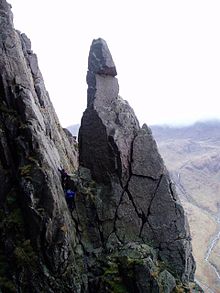
| Part of a series on |
| Climbing |
|---|
| Lists |
| Types of rock climbing |
| Types of mountaineering |
| Other types |
| Key actions |
| Key terms |
In the history of rock climbing,[a] the three main sub-disciplines – bouldering, single-pitch climbing, and big wall (and multi-pitch) climbing – can trace their origins to late 19th-century Europe. Bouldering started in Fontainebleau, and was advanced by Pierre Allain in the 1930s, and John Gill in the 1950s. Big wall climbing started in the Dolomites, and was spread across the Alps in the 1930s by climbers such as Emilio Comici and Riccardo Cassin, and in the 1950s by Walter Bonatti, before reaching Yosemite where it was led in the 1950s to 1970s by climbers such as Royal Robbins. Single-pitch climbing started pre-1900 in both the Lake District and in Saxony, and by the late-1970s had spread widely with climbers such as Ron Fawcett (Britain), Bernd Arnold (Germany), Patrick Berhault (France), Ron Kauk and John Bachar (USA).
As a free solo exercise with no artificial aid or climbing protection, bouldering remained largely consistent since its origins. Single-pitch climbing generally stopped using artificial aid in the early 20th-century, led by Paul Preuss, so-called "free climbing". Free climbing of Big Walls started before World War I, and was advanced by Emil Solleder in the 20s, Batista Vinatzer in the 30s, and Mathias Rebitsch in the late-40s. Climbing protection was needed for single-pitch and big-wall free climbing, and was inserted into the route while climbing; this is now called "traditional climbing". By the 1980s, French pioneers like Patrick Edlinger wanted to climb rock faces in Buoux and Verdon that had few cracks in which to insert traditional climbing protection. Controversially, they pre-drilled bolts from above on rappel, using battery powered drills, into potential new routes for protection (but not as artificial aid); this became known as "sport climbing". It led to a dramatic increase in climbing standards, grades, and tools (e.g. artificial climbing walls and campus boards), the development of competition climbing (initially dominated in the 1990s by French climbers such as François Legrand), and the "professional" rock climber.
By the end of the 20th-century, the hardest sport climbs were often combinations of bouldering-moves, and some of the best challenges lay in free climbing extreme big walls; this led to greater cross-over amongst the three sub-disciplines. Leading climbers such as Wolfgang Güllich, Jerry Moffatt, Alexander Huber, Fred Nicole, Chris Sharma, Adam Ondra, and Tommy Caldwell set records in several of these disciplines. Güllich and Huber also made ever-bolder single-pitch free solo climbs, while Sharma pushed standards in deep-water soloing; Alex Honnold's big wall free soloing was turned into the Oscar-winning film, Free Solo. In 2016, the IOC announced that competition climbing would be a medal sport in the 2020 Summer Olympics.
Female rock climbing developed later in the 20th-century but by the 1980s, climbers such as Lynn Hill and Catherine Destivelle were closing the gap to the standard of routes being climbed by the leading men. By the 21st-century, Josune Bereziartu, Angela Eiter and Ashima Shiraishi, had closed the gap to the highest sport and boulder climbing grades achieved by men to within one/two notches; Beth Rodden fully closed the gap for traditional climbing grades in 2008 and Janja Garnbret became the most successful competition climber in history with 42 IFSC world cup golds.
- ^ Zhu, Beifeng; Chen, Ruizhi; Li, Yuan (9 August 2021). "The Origin and Early Evolution of Rock Climbing". Advances in Social Science, Education and Humanities Research. Proceedings of the 2021 5th International Seminar on Education, Management and Social Sciences (ISEMSS 2021). 571. Atlantis Press: 662–667. doi:10.2991/assehr.k.210806.124. ISBN 978-94-6239-414-8.
Cite error: There are <ref group=lower-alpha> tags or {{efn}} templates on this page, but the references will not show without a {{reflist|group=lower-alpha}} template or {{notelist}} template (see the help page).
